Best ways to deal with Fabric tears and holes
Repairing clothes is not the happiest of all sewing jobs I know. But it is sometimes a necessary thing you ‘have’ to do, when you see holes in a favourite garment you do not want to lose yet.
You could have had that hole due to several reasons – some acidic thing fell on the garment, moth ate away fabric fibers and left small holes, seam stitching frayed the fabric, you snagged the clothing on something sharp, buttons and other fasteners strained the fabric and tore the area. Another common cause of holes is something like the belt buckle or the purse edge or the kitchen sink continuously touching a particular area and in time wearing down the place to make holes (you will never notice this till you get that hole gradually).
In our house most of the time, clothes get holes because of incorrect pressing – the iron box burns holes in the fabric very easily when the temperature is not compatible. This happens with synthetic clothing than ones made with natural fabrics. Actually, polyester clothing is more likely to get these holes than any type of cotton fabric, linen etc – just prevent them before they are even made. More of that, below.
Related post : Fixing holes in jeans – 8 ways.; One of them is the picture below.
Let us look at the different ways you can repair those holes to make the garment almost like it was earlier. You may want to learn some easy hand stitches
How to mend tears on fabrics and clothes
1. Easy hand stitch for long tears
If you have a long tear on a fabric you can repair it easily with a matching thread and thin needle.
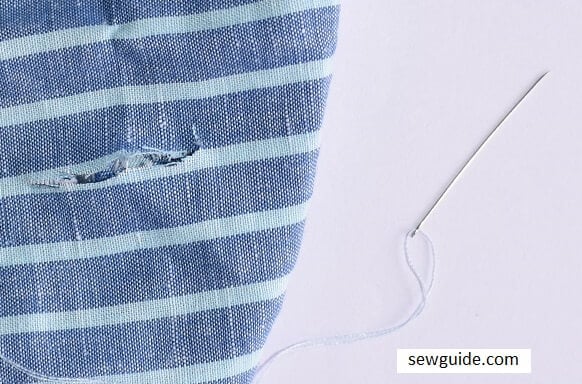
Cut out loose threads from inside the tear (not too much though)
Make the stitches as shown in the picture and you have a good enough mending.
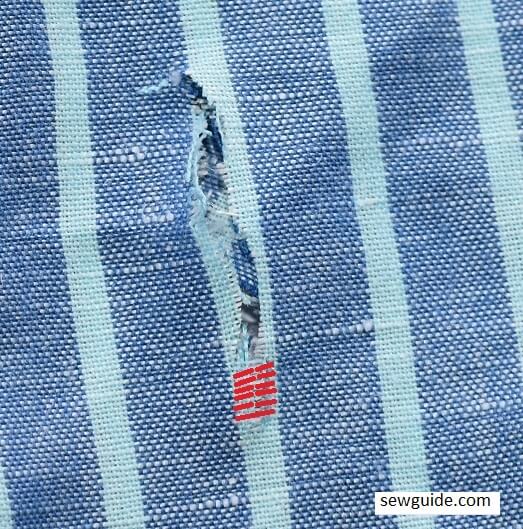
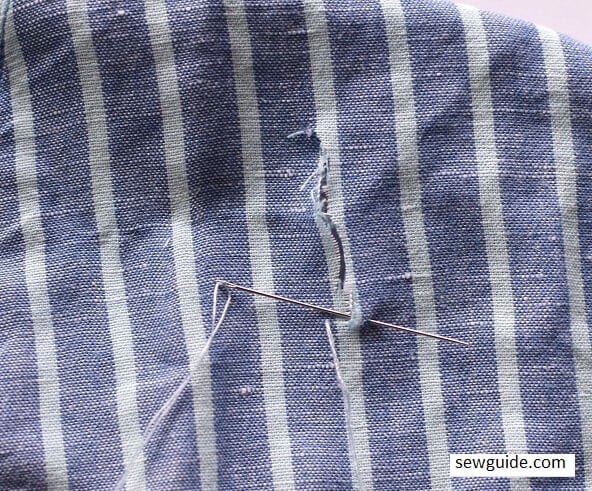
It is no magic bullet and doesnot make the tear disappear but it is definitely better looking than a tear. On fabrics with busy prints you can make it look part of the print.
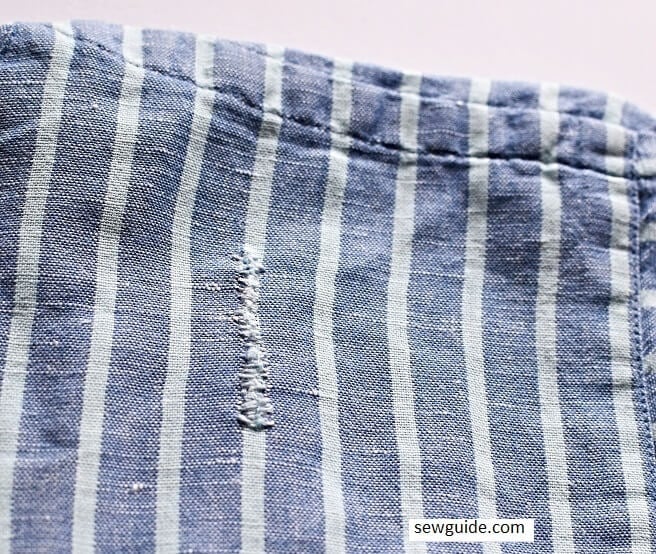
2. Simple adjustments for pinhead holes
If you have a knit fabric dress/top/leggings whatever, small holes (pinhead sizes) are a given. Simple small holes can be repaired fast on these fabrics. Just turn the clothing inside out. Take a big needle and carefully arrange the nearby threads to cover the small hole. Ever so lightly, stretch the fabric in all the directions and the hole most probably will repair itself.
3. Mending with fusible web/ iron on mending fabric
If the tear is very small and is on thin fabrics like t-shirt knits an immediate solution is to keep a thin lightweight fusible interfacing under the tear and press with hot iron. The small hole will mend, as the cut thread will fuse to the interfacing underneath.
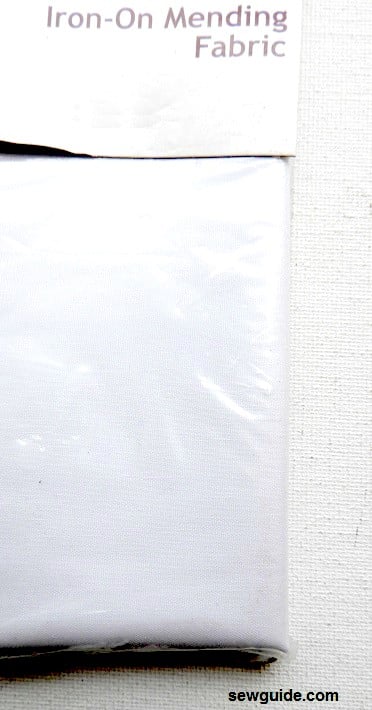
You can use the iron-on-mending fabric available in stores for this same purpose. This fabric comes with adhesive on one side. The disadvantage is that this method is not suitable for synthetic fabrics like polyester, nylon or even rayon (or use with ultra caution).
You will have to ever so lightly stretch the hole as you press so that the loose threads will adhere to the interfacing underneath
Use a pressing cloth between the fabric and iron to prevent press marks.
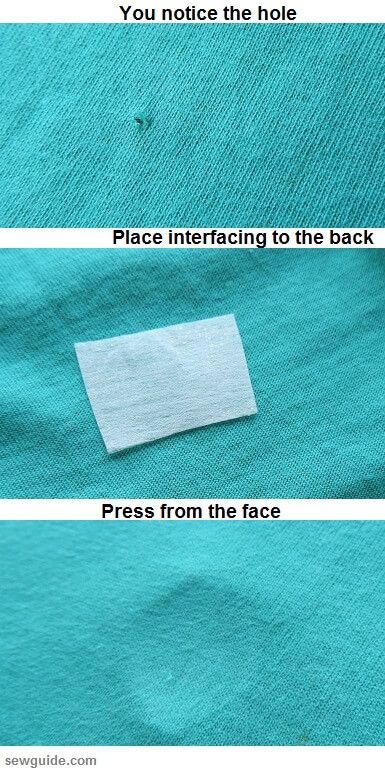
4. Mending with fusible web & stitching
If the tear is longer without too much depth you can use the fusible interfacing underneath and then use joining stitches to join the edges together as in a butt seam. Use a very closely matched colour thread to stitch this. You can use zigzag stitches to butt the seam
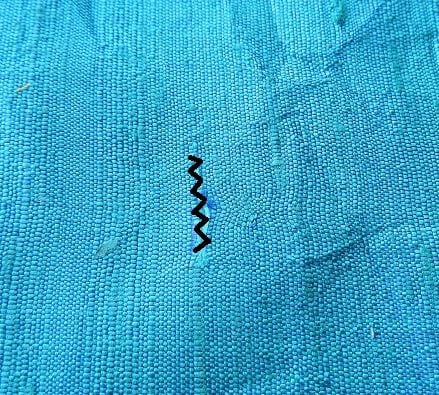
If you have a long tear, another option is to keep the fabric edges right sides together and sew them together as if it is a seam. This works better with patterned or textured fabric as the seam will not be very visible.
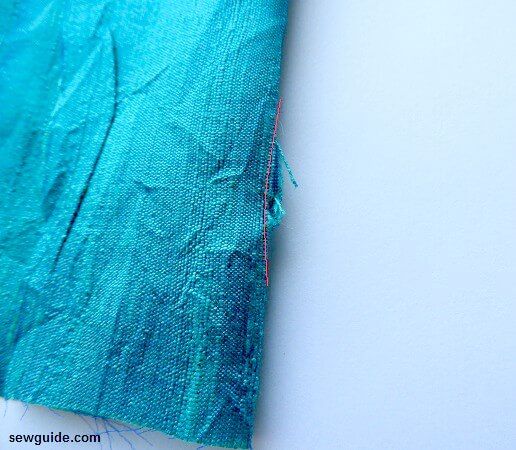
You will have to stitch very close to the fabric edges and even closer near the tips, like you are sewing a dart. Now open it up and press. Finish the fabric edges with fray check sealant or small whip stitches, otherwise, before long the tear will open up again.
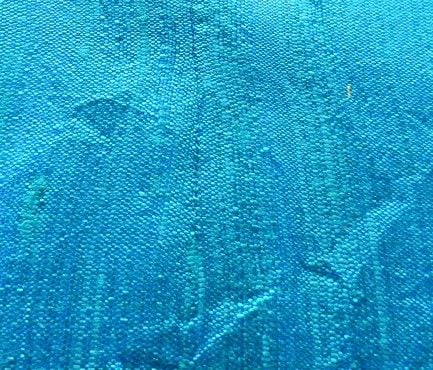
5. Use mending glue for fabrics
Sometimes you cannot bother to sew or the rip is in an area you simply cannot sew, like in a sofa, car seats.The mending glue can be used to mend seam rips like that of a ripped open pocket. You will have to keep the area tightly clamped overnight after a generous application of the glue and not wash it for a day or so for proper adherence.
There are special fabric glues that can seal the small tears on fabric almost invisibly. A waterproof layer is formed by the glue as soon as it is applied on the fabric surface. This can be a solution for repairing small tears when you have no option to use any of the options given above and below.
6. Seam repair – Mend a Rip in the seam
If the rip is on a seam, you can machine stitch easily enough – just sew the seam with a straight stitch remembering to anchor thread with back stitches at the starting and ending so that stitching would not get undone. Here are the 19 ways to sew a seam. If your seam is anything other than the normal variety you will need to read the post.
But what if you are in a place with no sewing machine in sight – just take out your sewing emergency kit -thread your needle and make a ladder stitch.
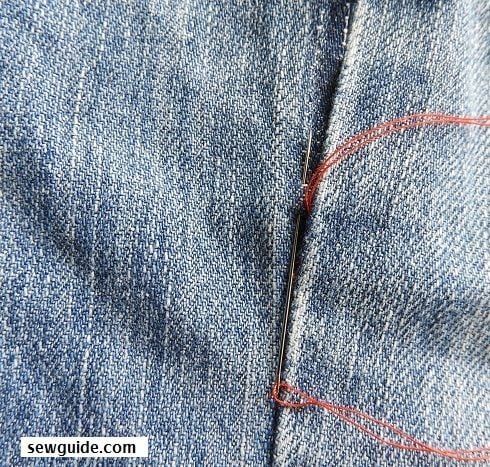
Ladder stitch is a pretty cool hand stitch which makes your stitching invisible.
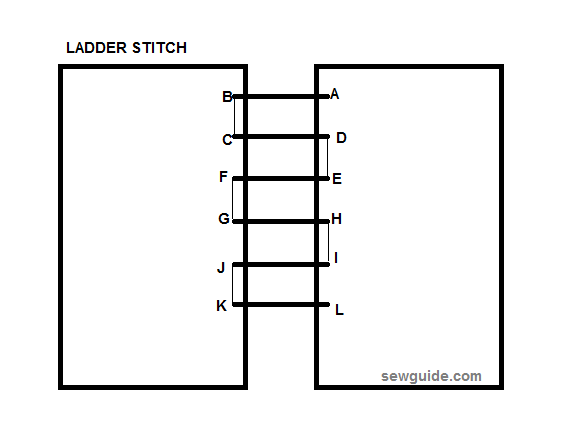
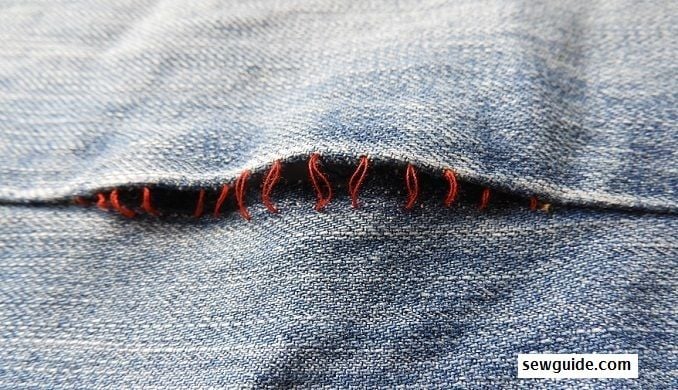
Check out the posts on the 17 best ways to sew seams, flat fell seam used on jeans, shirts etc, How to sew a ladder stitch, 9 basic and easy to do hand stitches and invisible stitches for more details.
7. Darning stitches
When you say Invisible mending, it is invisible darning that is at the heart of it. Darning is used when the hole is bigger – when the fabric has singed/frayed due to thin fibers etc you may have to cut away the scorched/frayed portion and this makes it too big for the above solutions. Darning will replace the fabric fibers which are missing.
Learn more in detail with step by step instructions about Darning here.
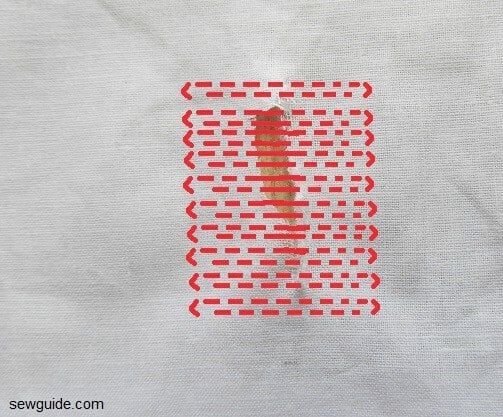
Darning involves sewing the rip/tear and covering it with very small stitches in the same colour as the background fabric. You can use hand sewing needle and thread or a sewing machine with a darning foot to make the darning stitches.
8. Decorative stitches
You can also use decorative stitches like an arrowhead stitch or other filling stitches to cover the rips and tears.
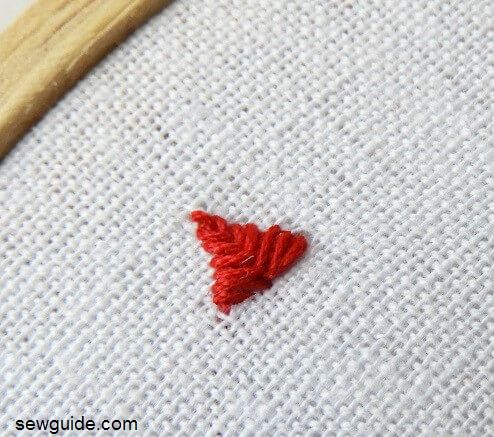
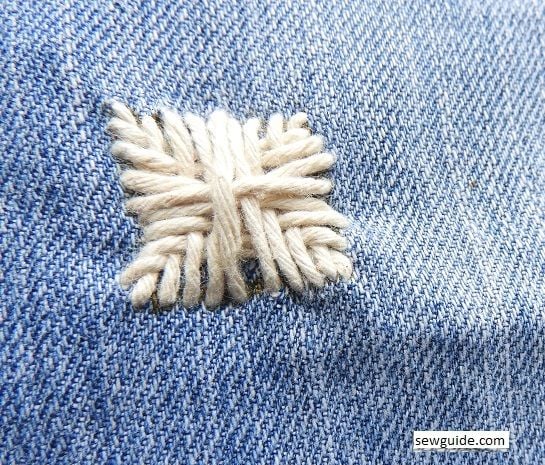
You can find instructions to make this stitch here.
9. Mending with clothing patches
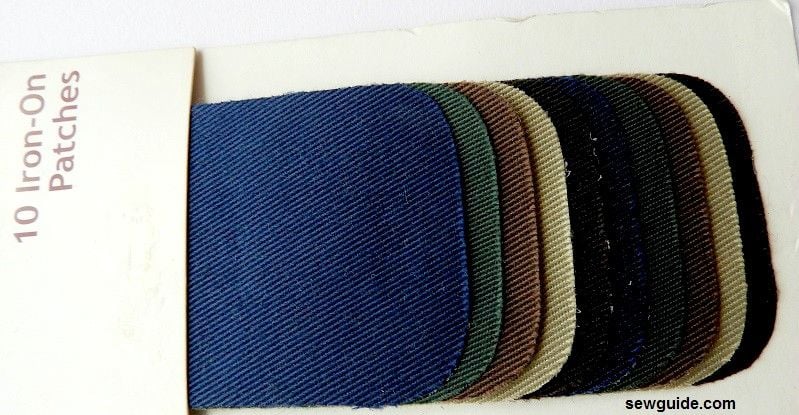
This involves getting a fabric piece from the same garment or a store bought one like the above picture and then using it to repair the tear/hole.
There are many ways you can sew hand cut / hand made clothing patches on to the fabric and many ways to make those clothing patches. 8 ways to attach them are described in the post ” different ways to sew clothing patches“
Best clothing patch is fabric taken from the garment itself. Self-fabric for the patching can be taken from anywhere there is excess fabric like a wide turned hem, facing, extra-wide seam allowance. If you can somehow cut a little of the fabric to cover the hole/tear this can be used to cover up the hole perfectly. With clever invisible stitching, no one will be the wiser about the hole after you have done patching
Calico patching refers to patching fabric with a similar cloth as the base fabric. Print patching involves patches which have to be matched and is done on patterned and chequered fabric
10. Patching and Darning
This is a method of machine darning.
My favourite method of sewing the clothing patches involves combining darning stitches with the patch. Keep a correctly matching colour fabric (of the same weight) or a knit fabric under the hole, use your free motion stitching skills ( or straight stitches or zig zag stitches) and a matching thread – run the stitches over the hole ( stitch from the top) just like the thread is woven in the fabric- till you are sure the whole hole is covered.If it is a matching fabric it will look almost invisible.
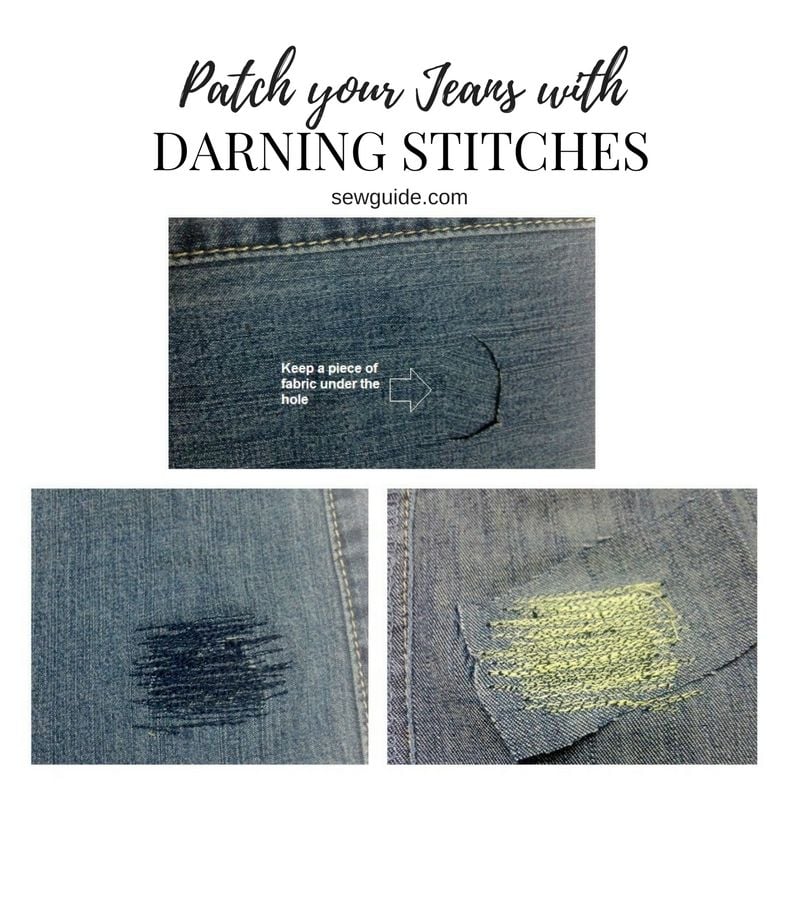
Sometimes a whole section of the clothing is replaced with another piece of clothing (Patch) – others will never guess that this was done because you wanted to mend a tear. They will just think you are fashionable or quirky, depending on the way you have sewn it or the way they look at it
Ready made patches
You can also buy the ready made assorted clothing patches available at stores. These come in sizes like 5 x 5 inches and can be applied easily enough. You just need to iron on them.
But they are not very durable and peel off after a few washes, unless you sew them in place. You cannot use them on fabrics like nylon or rayon or fabrics made of monofilament polyesters which can get damaged by heat. But it is a quick fix to mend holes on other fabrics -cotton, denim etc.
11. Decorative applique /ornamental patching
Applique is a fabric embellishment technique of using other fabric pieces to decorate a fabric. You will be using decorative stitches to sew applique. When used to mend holes in fabric it is also called ornamental patching.
The advantage of this method is that you are decorating your fabric at the same time mending it; the disadvantage is that an applique is a very conspicuous as a method of mending holes ( unlike the almost invisible repairs mentioned earlier)
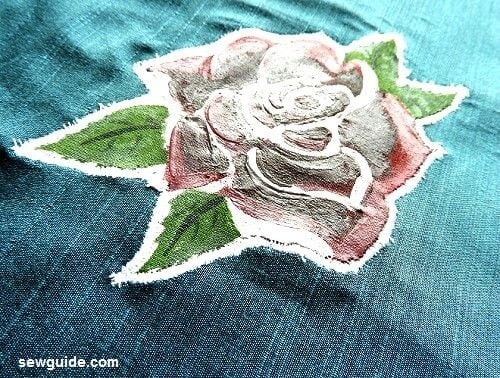
There are many ways that you can use applique. You can hand sew applique or do machine applique. Check out the tutorials for more instructions. You will need an applique piece which is at least 1/2 inch bigger all around than the hole/ tear. An embroidered fabric patch can be made following this tutorial and used to cover the hole.
Reverse applique is another technique which is as effective. This involves keeping the applique fabric under the hole; you can get a wonderful texture and beauty by using different kinds of fabrics with this technique. Keeping net/lace or other open weave fabrics can give a peekaboo look. Check out the 4 ways of doing reverse applique here
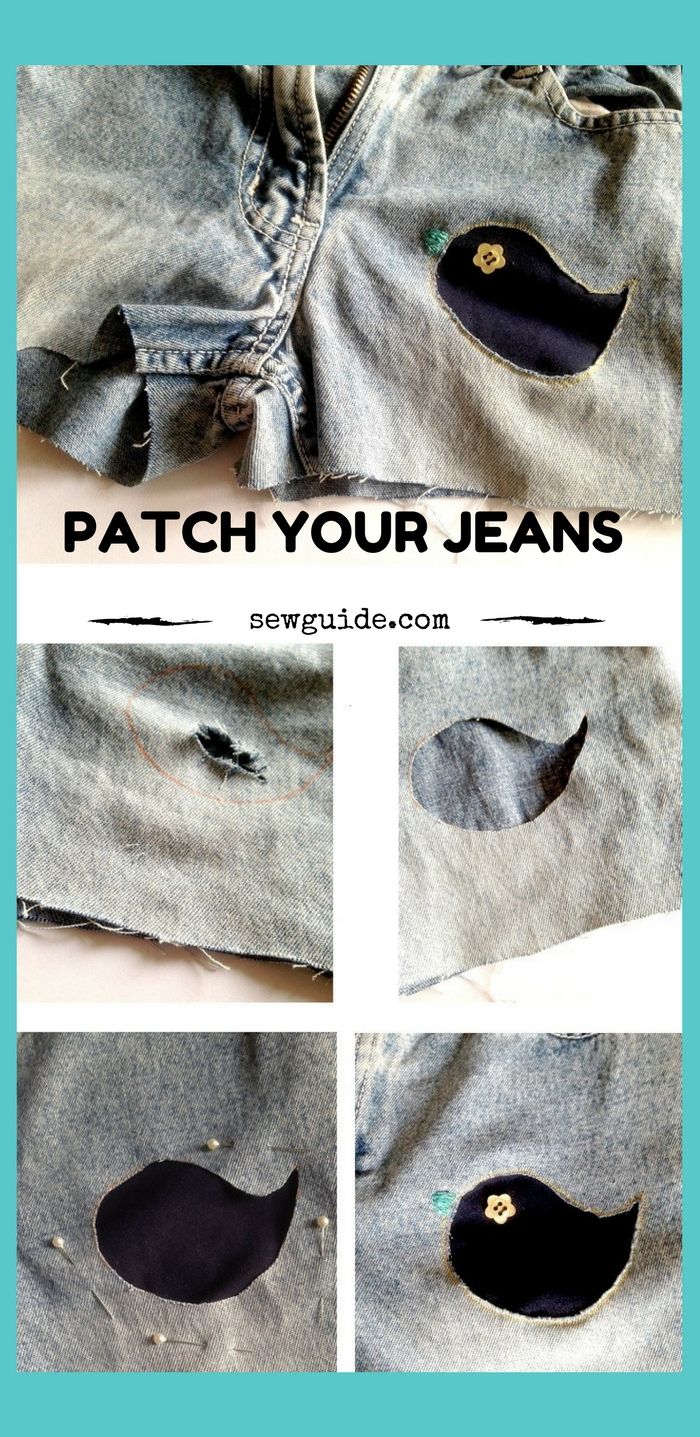
12. Embellish with trims/ beadwork/sequins/fabric flowers
If the hole is in an appropriate place you can use some embellishments over the hole to cover it up. You may have to replicate the design on other areas of the garment for it to look natural.
Look up tutorials to sew sequins, beadwork stitches, beadwork flowers, make fabric roses etc which can be useful to cover up a tear in the fabric
13. Cut and alter to avoid the tear
If the cut or hole is beyond repair or you cannot summon the energy to repair it carefully, you can make some alterations to the clothing so that the hole is stitched/cut away. For example, if you find a hole in the sleeve hem, cut the hem away and sew a new hem or add some extra fabric there as a band or cuff to add the length you lost. Where is the hole now???.
14. Wear the tear aka ripped clothes/peekaboos
My favourite joke about the difference in clothing and fashion sense across generations goes like this.
Teen comes out of the dressing room in ripped jeans
Mom says ” We’ll get this at 50% off -it has got holes in it”
Alright, But the holes have to be in the right places. Find out the different ways people make ripped jeans and the best places for the rips
Some holes may need some finishing at the fabric edges otherwise the hole will keep on getting bigger and you may not want the frayed edge look. You can sew a facing and turn the facing to the inside or just whip stitch the edges for a simple look or just make a running stitch inside the edge, leaving the frayed thread as it is.
15. Prevent holes and tears
Prevention is the best solution to all these, of course.
Just be careful – a small fire from a cigarette lighter could leave a burnt hole, buttons hastily pulled can make a hole, walking carelessly near projecting things like door handles could tear clothes; And the worst of all and the most common of all – iron setting kept in linen/cotton when pressing nylon is disastrous. The birth of a lot of holes in clothes in our house.
One way to prevent holes and tears if you are sewing the garment is to use a double thickness of fabric in places where you know there will be a hole – like knees of kids pants, under the armpit, elbows of work clothes etc. Interface behind buttons, buttonholes and other fasteners to prevent holes that result from constant pressure there.
A stitch in time saves nine. Maybe the hole is now a very small one or just started as a small tear- but waiting for repairing it is waiting for a catastrophe in the life of that clothing. Tears inevitably grow. Diligent people darn even before a hole is formed. When you feel that a hole will be inevitable by the look of a worn-out place like the knee of a kid’s pants you can start the darning. This will prevent the actual hole from forming.
Fraying near the seams in case of thin fabric can be prevented by using interlining or even attaching interfacing tape on the seams.
When you wear the same clothes, again and again, holes are inevitable. Rotating clothes so that all are worn equally can make sure that this is prevented.
The last but not the least important point is to clean and maintain the clothing so that you do not get tears and holes. ie some of the wear and tear is inevitable but most can be prevented with basic garment care. Check out the posts on hand washing clothes for longevity, using a laundry wash bag for delicate snaggable clothes etc. Rubbing clothes with hard brushes to remove stains will eventually lead to holes. Use other gentler solutions for stains. Check out this post on some homemade stain removers for clothes
Mending is time-consuming but yields good results and a feeling of satisfaction of having done something towards sustainable living. I promise myself I will do it more often, rather than throw away good clothing at the first sign of a hole or two. What about you?
Learn more about garment care here.
Related post: Clothing repair: 40 common problems solved.

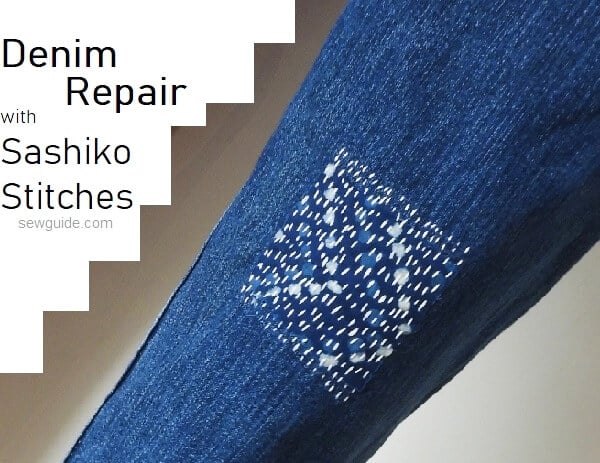
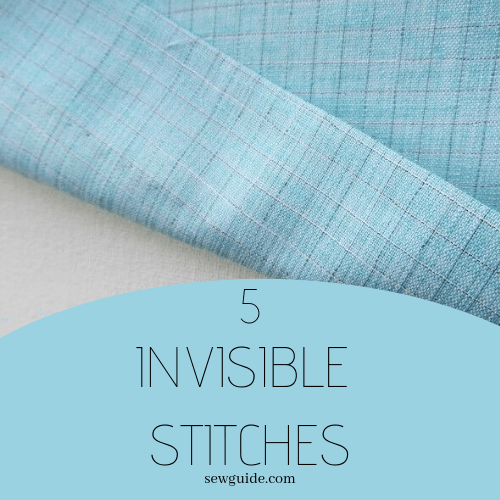


Wow! To the nasty person who left the comment: “If I accidentally change the direction the earth rotates, folks, sorry!” — you are quite full of yourself aren’t you. The advice is there, up to you if you use it, or not. No drama needed on your part.
I love this, keep it up, thanks.
I have a quilt with the binding already attached and now there is a hole with frayed edges in the binding. I planned to show this quilt. 100% cotton. Any ideas?
Can you not re-bind removing the binding which is frayed. Find easy tutorial to bind edges here.
I have a hole in the binding of a quilt I want to show. I can’t remove the binding. Any advice
Good tips. But you can’t just say “The disadvantage is that this method is not suitable for synthetic fabrics like polyester, nylon or even rayon (or use with ultra caution),” regarding use of fusible tape repairs. I mean, why not? Does it simply not adhere? Your cautionary note seems to suggest it is dangerous, but I can’t imagine that.
Btw I’m looking to repair a jacket lining, frayed near the edges, which really should be replaced rather than repaired. But I’m not about to do that. So I am in search of a solution. I may try the fusible tape route regardless of your caution. If I accidentally change the direction the earth rotates, folks, sorry!
🙂 Not dangerous to the world, but to the fabric. If the heat is too much these fabrics can melt or shine or pucker…..
if you get a miradry treatment it help to save on wear & tear on clothing & furniture by get sweat glands remove.
I have some silk pjama shorts that ripped in the seam. I managed to return them and get new ones but how do I prevent the material ripping again at the seams again? The shorts are roomy enough but I think when I sleep the material strains when I am in certain positions.
The term for this is seam slippage – the fabric coming apart at stitching line because of the weave or the quality of the fabric or tightness of the garment. You can reinforce the seam with store bought tape or bind the edges with a fabric strip or keep a fabric strip over the seam line on the back and sew it there.
Can you give me a brand of fabric flue that can be used to seal a small tear in fabric as you mention in #3 above?
Thanks for the very informative article! It seems that most of the examples here are on woven fabric, but I have a vintage jersey (nylon jersey/Qiana) dress which has a small run in it. The only “solution” I’ve found is the clear nail polish trick similar to what we all used on pantyhose growing up. Is there any better way to repair the run, and prevent it from spreading? Thanks!
Is it OK to darn with new thread on old fabric?
Hi, Sarina
I am doing a speech for my communication class on how to mend a rip or tear in clothing and was wondering if i could get your last name and the date of when this was originally posted so i can properly cite.
Hi Makayla
My full name is Sarina Tariq, Thanks for showing the interest : ) It was published on 2018/09/03. Best wishes
Hi Sarina,
Thanks for your reply to the previous comment. I am a student and loved one of your images with the tear in the jeans and red stitching. I would like to know if you are the author of the image? I was also like to cite it properly. I clicked through to pinterest but it just says sewingguide.com?
Thanks for your help,
Wendy
Hi Wendy
I wouldn’t know without seeing the image – you can maybe email me (contact page) the link to the one? But sewwinguide seems to be another website altogether.
yap its true prevention is the best thing to do and a cloth gets a damage quickly repair it to avoid other problems thanks
Side seams at the hip area on jeans need to be repaired sometimes. Do you have good suggestions for that? Side seams that are getting tattered.
Can you advise what to do with frayed silk curtains. The curtains cost a lot of money and are only a few years old but in certain places they have started to shred into ribbons. I can’t throw them away, but they’re looking awful. I was wondering about using a iron on web patch behind to hold it back together. What would you do?
Hi Tamzin, I know this is an older comment. It sounds like sun damage to your silk curtains (very common on unlined silk curtains). You can buy a silk needle (extra thin) and sew on a lining to minimize further damage. For the existing damage, is it near the edge? Maybe you can trim it off?
What do you recommend for polyester??? Very thin cardigan, ripping at the seam. The material is fraying so sewing would be difficult. I thought using a clear mending tape/patch to prevent further ripping and preserve the look since it is see-through-ish but then saw the tape/patch might not be suitable for this material. Please help! I only wore it once and really don’t want to give up on it. Thank you!!!
Thank you so much for this information. I hope you can help me I have a rather expensive linen shirt that I absolutely adore and the fabric is thinning almost to the point of a hole. It’s near the armpit but not on a seam. Any suggestions, would finding matching linen and fusing it from the back side work I’m concerned that when that top fabric wears away it is just going to fray. Thank you in advance
Hi Patti
This sounds like a darning candidate. You can get the thread from the shirt itself and weave the thread into the fabric – or give for professional darning.Check out this post on darning
I have the same issue! will be using fusible interfacing from the inside, and whipstitching along the inner (french) seams to secure the reinforcement. Those linen shirts are so good in the summer, and very expensive to replace often. Best wishes for your mending Patti.
These jeans have large holes from being to long, now he wants me to “fix them”. What technique would be recommended
Hi Pamela
Can you not patch it with another matching jean piece underneath and running darning stitches over- you can see it here https://sewguide.com/how-to-sew-clothing-patches/
A cat has clawed a vintage brocade dress in several places. What is the best way to repair it please?
Hi Beverly
That is so sad. Have you thought about embroidering ( or a bead motif) on the dress. Brocade is difficult to darn I think.
Well! It looks impossible. A well worn T-Shirt with lots of holes. The material is thin. My grandson asked me to “fix” it. Sure, I said. It has a grafic of four different trees and a flying bird and is signed by the designer. Ha. I have been to stores that do screen printing and sell T-shirts in lots. Too expensive. Tried iron on patching (denim). Too strong for this thin material. I looked for glue, tape, and other mending solutions….
I tried hand stitching the tears. The shirt is black and hard to see to hand stitch.
I have read your repair methods and think fusing material might work. But there are so many holes it would require lots of that. The size is xxx maybe 4x.
Hi Anne
That is unfortunate; thin t-shirts almost always develop these holes, especially in areas where there is more wear and tear like belt buckle etc. You will have to choose a thin fusible and then preferably hand wash . Best wishes
Late to this, but did you consider cutting out the graphic and fusing it or stitching it to another t-shirt? Or, better yet, framing it so he always has it.
Holes in a jean in between the legs